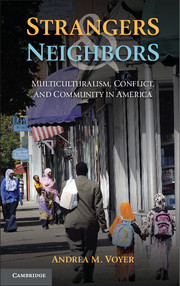Book contents
- Frontmatter
- Contents
- List of Figures and Tables
- Acknowledgments
- Introduction Strangers in a Strange Land
- 1 Ellis Island South and Maine’s Mogadishu
- 2 The Meaning of Somali Settlement and the Boundaries of Belonging
- 3 Being the Inclusive Community
- 4 Disciplined to Diversity
- 5 Familiar Strangers
- Conclusion Cultural Scaffolding
- References
- Index
5 - Familiar Strangers
Published online by Cambridge University Press: 05 June 2014
- Frontmatter
- Contents
- List of Figures and Tables
- Acknowledgments
- Introduction Strangers in a Strange Land
- 1 Ellis Island South and Maine’s Mogadishu
- 2 The Meaning of Somali Settlement and the Boundaries of Belonging
- 3 Being the Inclusive Community
- 4 Disciplined to Diversity
- 5 Familiar Strangers
- Conclusion Cultural Scaffolding
- References
- Index
Summary
Somali Faces
On Friday, January 6, 2006, the full-color front page of the Lewiston Sun Journal boasted a photograph unrelated to any story headlining that day. “A Smile Is Her Umbrella,” read the title of an image of a laughing African woman who had just slipped in the falling snow. The pink umbrella she had been carrying rested, up-ended, beside her. Her arms, face, and boots were covered in fresh, white snow. The caption read:
Oops! Haba Adbelmalik wipes snow off her face as she and her son Hamud have a laugh after she fell down the icy hill ... during Thursday’s snowstorm. She has been in Maine for less than a month and is still getting used to the snow and ice.
(Dillingham 2006, p. A1)On most days, Lewiston’s daily newspaper featured a color front-page photograph of people and places in the community. Somali residents of the city often appeared center stage in these photographs, taking a place within the paper’s parade of snowdrifts, senior citizens playing bingo, rainbows, icicles, puppies, children eating ice cream and running through sprinklers, dew-covered spider webs, and high school students heading out to a prom. In celebration of St. Patrick’s Day 2007, the Sun Journal featured a photograph of a young Somali girl at her school’s celebration of the holiday wearing “an Irish wristband to go with her green hijab” (Van Reeth 2007, p. A1). Other photographs depicted Somali women happily harvesting produce from their garden plots to take the famers’ market and tending their children at the playground. The paper presented images of graduating high school seniors wearing their mortar boards over their hijabs while awaiting their diplomas and Somali youth sitting alongside their classmates as they made care packages for members of the armed forces deployed in Iraq.
- Type
- Chapter
- Information
- Strangers and NeighborsMulticulturalism, Conflict, and Community in America, pp. 147 - 187Publisher: Cambridge University PressPrint publication year: 2013



